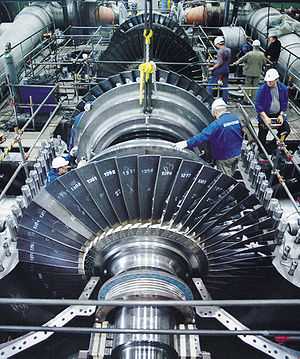Turbomachinery

Turbomachinery, in mechanical engineering, describes machines that transfer energy between a rotor and a fluid, including both turbines and compressors. While a turbine transfers energy from a fluid to a rotor, a compressor transfers energy from a rotor to a fluid. The two types of machines are governed by the same basic relationships including Newton's second Law of Motion and Euler's energy equation for compressible fluids. Centrifugal pumps are also turbomachines that transfer energy from a rotor to a fluid, usually a liquid, while turbines and compressors usually work with a gas.[1]
Classification

In general, the two kinds of turbomachines encountered in practice are open and closed turbomachines. Open machines such as propellers, windmills, and unshrouded fans act on an infinite extent of fluid, whereas, closed machines operate on a finite quantity of fluid as it passes through a housing or casing.
Turbomachines are also categorized according to the type of flow. When the flow is parallel to the axis of rotation, they are called axial flow machines, and when flow is perpendicular to the axis of rotation, they are referred to as radial (or centrifugal) flow machines. There is also a third category, called mixed flow machines, where both radial and axial flow velocity components are present.
Turbomachines may be further classified into two additional categories: those that absorb energy to increase the fluid pressure, i.e. pumps, fans, and compressors, and those that produce energy such as turbines by expanding flow to lower pressures. Of particular interest are applications which contain pumps, fans, compressors and turbines. These components are essential in almost all mechanical equipment systems, such as power and refrigeration cycles.[2]
| machine type → group ↓ | machinery | combinations of power and machinery | engines |
|---|---|---|---|
| open turbomachine | propeller | wind turbines | |
| hydraulic fluid machinery (≈ incompressible fluids) |
centrifugal pumps turbopumps and fans | Fluid couplings and clutches (hydrodynamic gearbox); Voith Turbo-Transmissions; pump-turbines (in pumped-storage hydroelectricity) | water turbines |
| thermal turbomachinery (compressible fluid) |
compressors | gas turbines (inlet of GT consists of a compressor) | steam turbines ← turbine jet engines |
Dimensionless ratios to describe turbomachinery

The following dimensionless ratios are often used for the characterisation of fluid machines. They allow a comparison of flow machines with different dimensions and boundary conditions.
- Pressure range ψ
- Flow number φ (including delivery or volume number called)
- Performance numbers λ
- Run number σ
- Diameter Number δ
Partial list of turbomachine topics
Many types of dynamic continuous flow turbomachinery are treated in Wikipedia. Below is a partial list of these topics. What is notable about these turbomachines is that the same fundamentals apply to all. Certainly there are significant differences between these machines and between the types of analysis that are typically applied to specific cases. This does not negate the fact that they are unified by the same underlying physics of fluid dynamics, gas dynamics, aerodynamics, hydrodynamics, and thermodynamics.
|
|
Turbomachines
Definition
Any devices that extracts energy from or imparts energy to a continuously moving stream of fluid (liquid or gas) can be called a Turbomachine. Elaborating, a turbomachine is a power or head generating machine which employs the dynamic action of a rotating element, the rotor; the action of the rotor changes the energy level of the continuously flowing fluid through the machine. Turbines, compressors and fans are all members of this family of machines.
In contrast to Positive displacement machines especially of the reciprocating type which are low speed machines based on the mechanical and volumetric efficiency considerations, majority of turbomachines run at comparatively higher speeds without any mechanical problems and volumetric efficiency close to hundred per cent.
Categorization
Turbomachines can be categorized on the basis of the direction of energy conversion:
- Absorb power to increase the fluid pressure or head (ducted Fans, compressors and pumps).
- Produce power by expanding fluid to a lower pressure or head (hydraulic, steam and gas turbines).
Turbomachines can be categorized on the basis of the nature of flow path through the passage of the rotor:
-
 Axial Turbomachine's Velocity Diagram
Axial Turbomachine's Velocity Diagram
In the figure:
- U = Blade velocity,
- Vf = Flow velocity,
- V = Absolute velocity,
- Vr = Relative velocity,
- Vw = Tangential or Whirl component of velocity.
-
 Radial Turbomachine's Velocity Diagram
Radial Turbomachine's Velocity Diagram
In the figure:
- U = Blade velocity,
- Vf = Flow velocity,
- V = Absolute velocity,
- Vr = Relative velocity,
- Vw = Tangential or Whirl component of velocity.
- Mixed flow turbomachines – When the flow is partly radial and partly axial, the device is termed a mixed flow turbomachine. It combines the advantages of both radial and axial type. Ex Francis Turbine.
Turbomachines can finally be classified on the Basis of whether pressure changes are absent or present respectively in the flow through the rotor:
-
 An Impulse Turbomachine Stage
An Impulse Turbomachine Stage
-
 A Reaction Turbomachine Stage
A Reaction Turbomachine Stage
See also
- Secondary flow in turbomachinery
- Exoskeletal engine - an inside-out turbine
- Turbocharger
- Slip factor
- Blade solidity
- Three-dimensional losses and correlation in turbomachinery
- Effects of mach number and shock losses in turbomachines
Sources
- Sydney Lawrence Dixon, Fluid mechanics and thermodynamics of turbomachinery,Butterworth–Heinemann (Elsevier), 1998. ISBN 0-7506-7870-4.
- Earl Logan (1993). Turbomachinery: basic theory and applications. CRC Press. ISBN 978-0-8247-9138-4.
- Erian A. Baskharone (2006). Principles of turbomachinery in air-breathing engines. Cambridge University Press. ISBN 978-0-521-85810-6.
References
- Chapter-1, Turbines Compressors and Fans - S M Yahya
External links
| Wikimedia Commons has media related to Turbomachinery. |